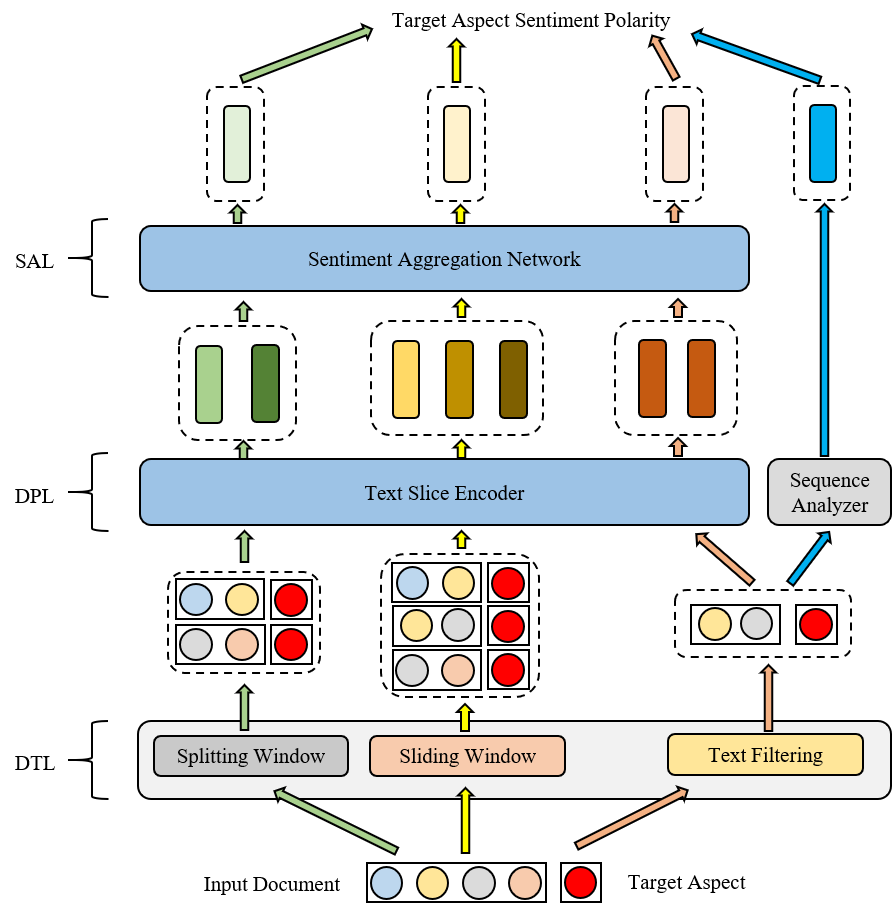Hierarchical Aspect-Oriented Framework for Long document (HAOFL) is a framework developed for document-level Aspect Based Sentiment Classification (ABSC) task.
Previous ABSC tasks are all sentence-level, which means the analyzed contents that contain several aspects are short texts with single-digit sentences. These contents are similar to reviews in shopping platforms and tweets. However, long news and long blogs are much different from these sentence-level contents. What is the performance of existing sentence-level ABSC models on these long documents?
We focus on processing long dependencies and aggregating complex sentiment to propose a framework, HAOFL. This framework has three functional layers to play important roles in solving document-class ASBC task.
- Data Transformation Layer (DTL) is a layer pre-processes the input long document. There are three data transformation methods in DTL, splitting window, sliding window, and text filter. Splitting window and sliding window will obtain little text slices by the number of words, while text filter can locate target aspects and extract neighbor sentences.
- Dependency Processing Layer (DPL) can analyze the sentiment dependency in a text slice. There are two modes in this layer, encoder mode and analysis mode. Encoder mode analyzes the single text slice and generates the sentiment representation of this text slice. Analysis mode studies the sentiment information of all text slices and obtains the overall sentiment representation of the document. Notably, analysis mode can be chosen only when text filter is the data transformation method in DTL. The model used in DPL can be sentence-level ABSC models, but these models should adjust for some differences between documents and sentences.
- Sentiment Aggregation Layer (SAL) can aggregate the local sentiment representation of text slices and produce a global sentiment representation of the whole document. If the mode of DPL is analysis, SAL will do nothing because the result of analysis mode is already the global sentiment representation of the whole document.
HAOFL is implemented with Python3, other packages are listed:
- pytorch == 1.4.0
- numpy == 1.18.2
- ransformers == 2.9.1
- spacy == 2.2.4
You should download the pre-trained model used by the spaCy.
python3 -m spacy download en_core_web_smThen, you can running model to perform the document-level ABSC task with HAOFL based models.
python3 train.py --model_name <name of the model>We have implemented 9 types of HAOFL based model, except for the baseline, we also integrated sentence-level ABSC models, ATAE, IAN, Memory Network, AOA, RAM, TNET, MGAN, and BERT. Running commands for these models are the following.
-
Baseline
python3 train.py --device cuda:1 --dtl_method <method_name> --dpl_mode <mode_choice>
-
ATAE
python3 train.py --model_name atae --device cuda:1 --dtl_method <method_name> --dpl_mode <mode_choice>
-
IAN
python3 train.py --model_name ian --device cuda:1 --dtl_method <method_name> --dpl_mode <mode_choice>
-
MemNet
python3 train.py --model_name memnet --device cuda:1 --dtl_method <method_name> --dpl_mode <mode_choice> --name_tail NoAspectInText
-
AOA
python3 train.py --model_name aoa --device cuda:1 --dtl_method <method_name> --dpl_mode <mode_choice>
-
RAM
python3 train.py --model_name ram --device cuda:1 --dtl_method <method_name> --dpl_mode <mode_choice> --name_tail position
-
TNET
python3 train.py --model_name tnet --device cuda:1 --dtl_method <method_name> --dpl_mode <mode_choice> --name_tail position
-
MGAN
python3 train.py --model_name mgan --device cuda:1 --dtl_method <method_name> --dpl_mode <mode_choice> --name_tail position
-
BERT
python3 train.py --model_name bert --device cuda:1 --dtl_method <method_name> --dpl_mode <mode_choice> --embed_dim 768 --hidden_dim 768 --batch_size 1 --learning_rate 0.00001
Notably, the name_tail is a tag for a self-defined data pre-processing method. For
example, RAM, TNET, and MGAN all adopt relative position encoding methods, so we
implement a subclass for DTL layer, and the name_tail is position. When BERT is
integrated, the GPU RAM is out of the bound, so we assign the batch_size to 1.
The running situation of these models are shown in following table.
| Model Name | Splitting Window | Sliding Window | Text Filter | Analysis Mode |
|---|---|---|---|---|
| baseline | ✔️ | ✔️ | ✔️ | ✔️ |
| atae | ✔️ | ✔️ | ✔️ | ✔️ |
| ian | ✔️ | ✔️ | ✔️ | ✔️ |
| memnet | ✔️ | ✔️ | ✔️ | ✔️ |
| aoa | ✔️ | ✔️ | ✔️ | ✔️ |
| ram | ✔️ | ✔️ | ✔️ | ✔️ |
| tnet | ✔️ | ✔️ | ✔️ | ✔️ |
| mgan | ✔️ | ✔️ | ✔️ | ✔️ |
| bert | ✔️ | ❌ | ✔️ | ❌ |
The meaning of the latter four columns are:
- Splitting Window: "splitting window" method in DTL layer and "encoder" mode in DPL layer.
- Sliding Window: "sliding window" method in DTL layer and "encoder" mode in DPL layer.
- Text Filter: "text filter" method in DTL layer and "encoder" mode in DPL layer.
- Analysis Mode: "text filter" method in DTL layer and "analysis" mode in DPL layer.
There are two failures:
- BERT integrated model with "sliding window" method in DTL is out of GPU Memory
- The input of BERT integrated model with "analysis" mode in DPL is too long, which exceeds 512.
Among all methods, we recommend the approach "text filter" method with "encoder", which not only runs faster but also performs better.
Aspect-Oriented Long Text Dataset is a document-level dataset contains the contexts we collected. Corresponding aspects and polarities are obtained by Guoxin Cloud Service Co., Ltd. manually. Some information about AOLTD is show in following table.
| Set Type | Positive | Neutral | Negative |
|---|---|---|---|
| Training(full) | 799 | 1597 | 1597 |
| Test(full) | 234 | 817 | 652 |
| Training(released) | 200 | 400 | 400 |
| Test(released) | 100 | 200 | 200 |
The shortest content in AOLTD is about 140 words, which is longer than the longest content in normal sentence-level datasets, e.g. Semeval-14 laptop, Semeval-14 restaurant, and Twitter.
For some special reasons, we release a part of AOLTD now. The full version of AOLTD will be released in the near future.
Questions are welcome in 'Issue' module of this repository.
